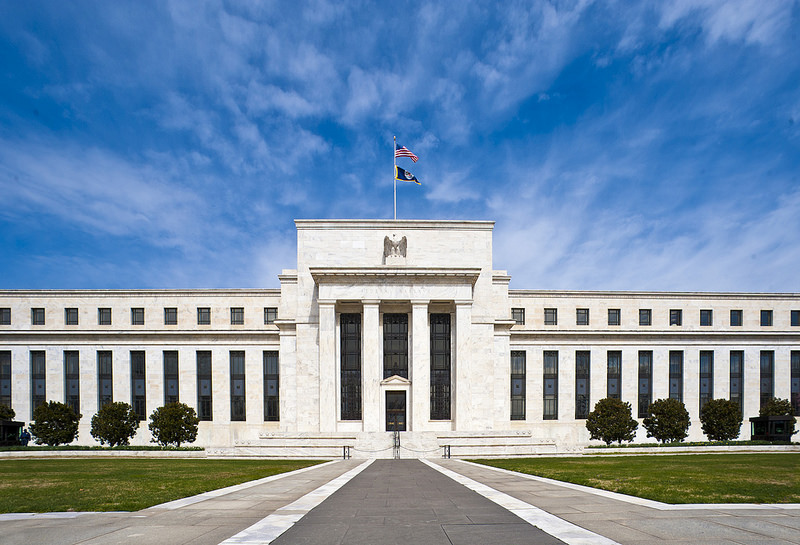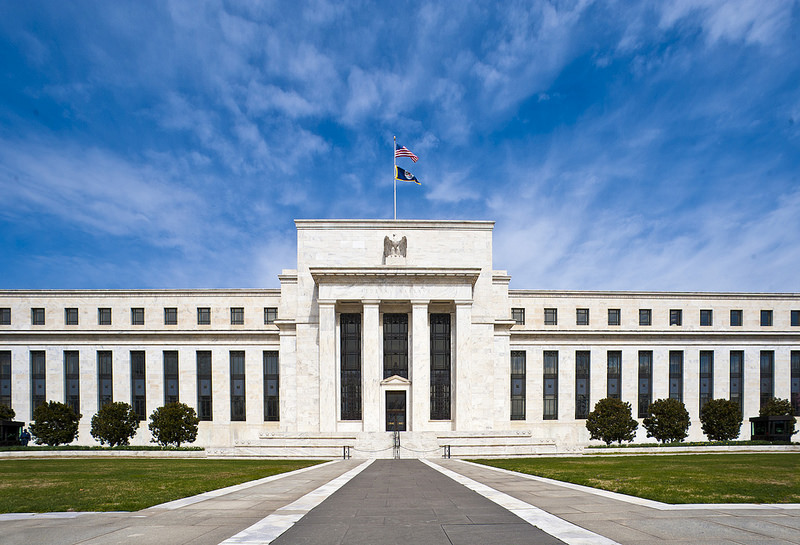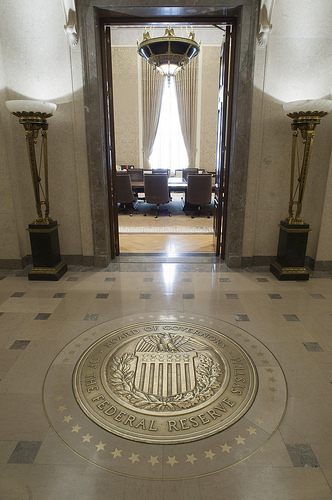Federal Reserve vice chairman Stanley Fischer: Remarks on the U.S. Economy
 Autor: Bancherul.ro
Autor: Bancherul.ro
2016-08-22 10:50
Vice Chairman Stanley Fischer
At the "Program on the World Economy" a conference sponsored by The Aspen Institute, Aspen, Colorado
August 21, 2016
Remarks on the U.S. Economy
The Fed's dual mandate aims for maximum sustainable employment and an inflation rate of 2 percent, as measured by the price index for personal consumption expenditures (PCE). Employment has increased impressively over the past six years since its low point in early 2010, and the unemployment rate has hovered near 5 percent since August of last year, close to most estimates of the full-employment rate of unemployment.
The economy has done less well in reaching the 2 percent inflation rate. Although total PCE inflation was less than 1 percent over the 12 months ending in June, core PCE inflation, at 1.6 percent, is within hailing distance of 2 percent--and the core consumer price index inflation rate is currently above 2 percent.1
So we are close to our targets. Not only that, the behavior of employment has been remarkably resilient. During the past two years we have been concerned at various stages by the possible negative effects on the U.S. economy of the Greek debt crisis, by the 20 percent appreciation of the trade-weighted dollar, by the Chinese growth slowdown and accompanying exchange rate uncertainties, by the financial market turbulence during the first six weeks of this year, by the dismaying pothole in job growth this May, and by Brexit--among other shocks. Yet, even amid these shocks, the labor market continued to improve: Employment has continued to increase, and the unemployment rate is currently close to most estimates of the natural rate.
During that period, the decline in the price of oil changed from being regarded as a simple reduction in the cost of living of almost all households--and thus an unmitigated blessing--to also being a source of concern, as it was understood that the decline in investment in the production and installation of drilling equipment mitigated the blessing, as did the decline in U.S. oil production.
And there have been other issues of concern to those particularly interested in monetary and macroeconomic policy, though probably of less explicit concern to the public: The decline in estimates of r*--the neutral interest rate that neither boosts nor slows the economy--which is related to the fear that we are facing a prolonged period of secular stagnation; the associated concerns that (a) the short-term interest rate will be constrained by its effective lower bound a greater percentage of time in the future than in the past, and (b) that the U.S. economy could find itself having to contend at some point with negative interest rates--something that the Fed has no plans to introduce; the fear that very low interest rates present a threat to financial stability; and concerns that low rates of real wage growth are increasing inequality in the distribution of income.
Primarily, I believe it is a remarkable, and perhaps underappreciated, achievement that the economy has returned to near-full employment in a relatively short time after the Great Recession, given the historical experience following a financial crisis.2 To be sure, it was a slow and difficult time for many, in part because growth in real gross domestic product (GDP) has been slow by historical standards. As can be seen in table 1, part of the slower output growth was due to smaller increases in aggregate hours worked, primarily reflecting demographic factors such as the aging of the baby-boom generation. But, as shown in table 2, there was also a major decline in the rate of productivity growth--to which I will return shortly.
Turning briefly to recent developments, the pattern of high employment growth and low productivity growth that we have seen in recent years has continued this year. So far in 2016, nonfarm payroll gains have averaged about 185,000 per month--down from last year's pace of 230,000, but still more than enough to represent a continued improvement in labor market conditions. Estimates of monthly job gains needed to keep the unemployment rate steady range widely, from around 75,000 per month to 150,000 per month, depending on what happens to labor force participation among other things.
Output growth has been much less impressive. Over the four quarters ending this spring, real GDP is now estimated to have increased only 1-1/4 percent. This pace likely understates the underlying momentum in aggregate demand, in part because of a sizable inventory correction that began early last year; even so, GDP growth has been mediocre at best.
The combination of strong job gains and mediocre GDP growth has resulted in exceptionally slow labor productivity growth. Most recently, business-sector productivity is reported to have declined for the past three quarters, its worst performance since 1979. Granted, productivity growth is often quite volatile from quarter to quarter, both because of difficulties in measuring output and hours and because other transitory factors may affect productivity. But looking at the past decade, productivity growth has been lackluster by post-World War II standards. Output per hour increased only 1-1/4 percent per year on average from 2006 to 2015, compared with its long-run average of 2-1/2 percent from 1949 to 2005. A 1-1/4 percentage point slowdown in productivity growth is a massive change, one that, if it were to persist, would have wide-ranging consequences for employment, wage growth, and economic policy more broadly. For example, the frustratingly slow pace of real wage gains seen during the recent expansion likely partly reflects the slow growth in productivity.3
Let me highlight a few topics from the growing volume of research on this topic. The first is that the productivity slowdown reflects mismeasurement, because the official statistics have failed to capture new and better products or properly account for changes in prices over time.4 Given how often we meet new technologies in our daily activities, even in classes of products that have been in operation for many years--from driving an automobile, to flying, to medicines and medical equipment, to our communications, and far more--it is easy to persuade ourselves that technological advances play a major part in improving our lives. However, some of these gains are conceptually outside the scope of GDP, and most recent research suggests that mismeasurement of output cannot account for much of the productivity slowdown.5
Another explanation is that business investment has been relatively modest during the current expansion, and so increases in capital per worker have been smaller than in previous decades. Part of the modest pace of investment is likely because the effective labor force that will use this new capital has been expanding much less rapidly than in previous decades, but it is also possible that investment has been restrained by the subdued outlook for growth and profits, thereby generating less demand for expanding productive capacity.6
However the slow growth in capital per worker has been quantitatively less important--accounting for only one-fourth of the slowdown in productivity compared with its long-run average--than the decline in the growth rate of total factor productivity (TFP), the portion of productivity that is not accounted for by measurable inputs to production. Indeed, TFP growth has averaged less than 1/2 percent per year in the past 10 years, well below its long-run average of 1-1/4 percent. Pinning down the exact causes of this slowdown is difficult, and there are many possibilities. For instance, it may reflect a slowdown in technological innovations, which may be persistent, as some have argued, or may be a temporary phenomenon, as I am inclined to believe.7
Low-to-middling TFP growth might also reflect the downward trend in business dynamism, as evidenced by a notable slowdown in gross job creation and destruction. Diminished dynamism has been linked to a marked slowdown in the reallocation of labor and capital from low-productivity establishments and firms to high-productivity ones, especially in innovative sectors like high tech.8 Both phenomena are closely related to the declining trend in new business creation.9
Are we doomed to slow productivity growth for the foreseeable future? We don't know.10 On the encouraging side, the technological frontier appears to be advancing rapidly in some sectors, and there are hints that the firm start-up rate is improving.11 On the more discouraging side, investment continues to disappoint--and so the current capital stock is smaller and embodies fewer frontier technologies than might otherwise be the case--and the productivity slowdown is a global phenomenon, suggesting that it may not be easily or quickly remedied.
Let me conclude by mentioning briefly one aspect of the low interest rate and low productivity growth problems--the fact that the Fed has been close to being "the only game in town," as Mohamed El-Erian and others have described it.12 At least one part of the solution can be found in the observation that overall macroeconomic policy does not have to be confined solely to monetary policy. In particular, monetary policy is not well equipped to address long-term issues like the slowdown in productivity growth. Rather, the key to boosting productivity growth, and the long-run potential of the economy, is more likely to be found in effective fiscal and regulatory policies.13 While there is disagreement about what the most effective policies would be, some combination of improved public infrastructure, better education, more encouragement for private investment, and more-effective regulation all likely have a role to play in promoting faster growth of productivity and living standards--and also in reducing the probability that the economy and particularly the central bank will in the future have to contend more than is necessary with the zero lower bound.
Source: Fed statement
Comentarii
Adauga un comentariu
Adauga un comentariu folosind contul de Facebook
Alte stiri din categoria: Noutati Federal Reserve
Federal Reserve urca dobanda la 2,25%
Federal Reserve (Fed) a urcat ieri dobanda cu un sfert de punct, la 2,25%, iar analistii estimeaza ca nu se va opri decat la 3%, in iunie 2019. Nivelul de 3% al dobanzii este cel pe care Fed il considera a fi nici expansionist nici contractionist, pe termen lung. De altfel, Fed considera ca deja dobanda este neutra, intrucat a eliminat din comunicat expresia "dobanda de politica monetara este acomodativa", ceea ce inseamna ca este mai mica decat ar trebui, pentru a stimula cresterea economica. Economia SUA este intr-o forma buna iar inflatia de baza este de doar detalii
Federal Reserve decided to maintain the target range for the federal funds rate at 1-1/2 to 1-3/4 percent
Federal Reserve issues FOMC statement (press release): Information received since the Federal Open Market Committee met in March indicates that the labor market has continued to strengthen and that economic activity has been rising at a moderate rate. Job gains have been detalii
Federal Reserve majoreaza dobanda de referinta pentru dolar la 1,5% - 1,75%
Federal Reserve (Fed), banca centrala a Statelor Unite, a majorat dobanda de referinta pentru dolar cu un sfert de punct, la un interval de 1,5%-1,75%, in conditiile cresterii inflatiei si a revigorarii economiei americane. Spre deosebire de alte banci centrale, care folosesc o dobanda detalii
Federal Reserve issues FOMC statement
Information received since the Federal Open Market Committee met in November indicates that the labor market has continued to strengthen and that economic activity has been rising at a solid rate. Averaging through hurricane-related fluctuations, job gains have been solid, and the unemployment detalii
- A Challenging Decade and a Question for the Future (speech by Janet Yellen, The Fed chair)
- Janet Yellen speech: Financial Stability a Decade after the Onset of the Crisis
- Janet Yellen - Semiannual Monetary Policy Report to the Congress
- Federal Reserve majoreaza din nou dobanda
- Federal Reserve raised the target range for the federal funds rate to 3/4 to 1 percent
- Janet Yellen: From Adding Accommodation to Scaling It Back
- Testimony by Chair Yellen on semiannual Monetary Policy Report to the Congress
- Federal Reserve keeps rate at 1/2 to 3/4 percent
- Speech by Fed chair Janet Yellen on the economic outlook and the conduct of monetary policy
- Minutes of the Federal Reserve
Criza COVID-19
- In majoritatea unitatilor BRD se poate intra fara certificat verde
- La BCR se poate intra fara certificat verde
- Firmele, obligate sa dea zile libere parintilor care stau cu copiii in timpul pandemiei de coronavirus
- CEC Bank: accesul in banca se face fara certificat verde
- Cum se amana ratele la creditele Garanti BBVA
Topuri Banci
- Topul bancilor dupa active si cota de piata in perioada 2022-2015
- Topul bancilor cu cele mai mici dobanzi la creditele de nevoi personale
- Topul bancilor la active in 2019
- Topul celor mai mari banci din Romania dupa valoarea activelor in 2018
- Topul bancilor dupa active in 2017
Asociatia Romana a Bancilor (ARB)
- Băncile din România nu au majorat comisioanele aferente operațiunilor în numerar
- Concurs de educatie financiara pentru elevi, cu premii in bani
- Creditele acordate de banci au crescut cu 14% in 2022
- Romanii stiu educatie financiara de nota 7
- Gradul de incluziune financiara in Romania a ajuns la aproape 70%
ROBOR
- ROBOR: ce este, cum se calculeaza, ce il influenteaza, explicat de Asociatia Pietelor Financiare
- ROBOR a scazut la 1,59%, dupa ce BNR a redus dobanda la 1,25%
- Dobanzile variabile la creditele noi in lei nu scad, pentru ca IRCC ramane aproape neschimbat, la 2,4%, desi ROBOR s-a micsorat cu un punct, la 2,2%
- IRCC, indicele de dobanda pentru creditele in lei ale persoanelor fizice, a scazut la 1,75%, dar nu va avea efecte imediate pe piata creditarii
- Istoricul ROBOR la 3 luni, in perioada 01.08.1995 - 31.12.2019
Taxa bancara
- Normele metodologice pentru aplicarea taxei bancare, publicate de Ministerul Finantelor
- Noul ROBOR se va aplica automat la creditele noi si prin refinantare la cele in derulare
- Taxa bancara ar putea fi redusa de la 1,2% la 0,4% la bancile mari si 0,2% la cele mici, insa bancherii avertizeaza ca indiferent de nivelul acesteia, intermedierea financiara va scadea iar dobanzile vor creste
- Raiffeisen anunta ca activitatea bancii a incetinit substantial din cauza taxei bancare; strategia va fi reevaluata, nu vor mai fi acordate credite cu dobanzi mici
- Tariceanu anunta un acord de principiu privind taxa bancara: ROBOR-ul ar putea fi inlocuit cu marja de dobanda a bancilor
Statistici BNR
- Deficitul contului curent după primele două luni, mai mare cu 25%
- Deficitul contului curent, -0,39% din PIB după prima lună a anului
- Deficitul contului curent, redus cu 17%
- Inflatia a încheiat anul 2023 la 6,61%, semnificativ sub prognoza oficială
- Deficitul contului curent, redus cu o cincime după primele zece luni ale anului
Legislatie
- Legea nr. 311/2015 privind schemele de garantare a depozitelor şi Fondul de garantare a depozitelor bancare
- Rambursarea anticipata a unui credit, conform OUG 50/2010
- OUG nr.21 din 1992 privind protectia consumatorului, actualizata
- Legea nr. 190 din 1999 privind creditul ipotecar pentru investiții imobiliare
- Reguli privind stabilirea ratelor de referinţă ROBID şi ROBOR
Lege plafonare dobanzi credite
- BNR propune Parlamentului plafonarea dobanzilor la creditele bancilor intre 1,5 si 4 ori peste DAE medie, in functie de tipul creditului; in cazul IFN-urilor, plafonarea dobanzilor nu se justifica
- Legile privind plafonarea dobanzilor la credite si a datoriilor preluate de firmele de recuperare se discuta in Parlament (actualizat)
- Legea privind plafonarea dobanzilor la credite nu a fost inclusa pe ordinea de zi a comisiilor din Camera Deputatilor
- Senatorul Zamfir, despre plafonarea dobanzilor la credite: numai bou-i consecvent!
- Parlamentul dezbate marti legile de plafonare a dobanzilor la credite si a datoriilor cesionate de banci firmelor de recuperare (actualizat)
Anunturi banci
- Bancile comunica automat cu ANAF situatia popririlor
- BRD bate recordul la credite de consum, in ciuda dobanzilor mari, si obtine un profit ridicat
- CEC Bank a preluat Fondul de Garantare a Creditului Rural
- BCR aproba credite online prin aplicatia George, dar contractele se semneaza la banca
- Aplicatia Eximbank, indisponibila temporar
Analize economice
- România - prima în UE la inflație, prin efect de bază
- Deficitul comercial lunar a revenit peste cota de 2 miliarde euro
- România, 78% din media UE la PIB/locuitor în 2023
- România - prima în UE la inflație, prin efect de bază
- Inflația anuală, în scădere la 7,23%
Ministerul Finantelor
- Datoria publică, imediat sub pragul de 50% din PIB la începutul anului 2024
- Deficitul bugetar, deja -1,67% din PIB după primele două luni
- Datoria publică, sub pragul de 50% din PIB la finele anului 2023
- Deficitul bugetar, din ce în ce mai mare la început de an
- Deficitul bugetar după 8 luni, încă mai mare față de rezultatul din anul trecut
Biroul de Credit
- FUNDAMENTAREA LEGALITATII PRELUCRARII DATELOR PERSONALE IN SISTEMUL BIROULUI DE CREDIT
- BCR: prelucrarea datelor personale la Biroul de Credit
- Care banci si IFN-uri raporteaza clientii la Biroul de Credit
- Ce trebuie sa stim despre Biroul de Credit
- Care este procedura BCR de raportare a clientilor la Biroul de Credit
Procese
- Un client Credius obtine in justitie anularea creditului, din cauza dobanzii prea mari
- Hotararea judecatoriei prin care Aedificium, fosta Raiffeisen Banca pentru Locuinte, si statul sunt obligati sa achite unui client prima de stat
- Decizia Curtii de Apel Bucuresti in procesul dintre Raiffeisen Banca pentru Locuinte si Curtea de Conturi
- Vodafone, obligata de judecatori sa despagubeasca un abonat caruia a refuzat sa-i repare un telefon stricat sau sa-i dea banii inapoi (decizia instantei)
- Taxa de reziliere a abonamentului Vodafone inainte de termen este ilegala (decizia definitiva a judecatorilor)
Stiri economice
- Producția industrială pe februarie, cu aproape 7% sub cea din urmă cu cinci ani
- Inflația anuală a revenit la nivelul de la finele anului anterior
- Pensia reală de asigurări sociale de stat a crescut anul trecut cu 2,9%
- Producția de cereale boabe pe 2023, cu o zecime mai mare față de anul precedent
- România, țara UE cu cea mai mare creștere a costului salarial
Statistici
- Care este valoarea salariului minim brut si net pe economie in 2024?
- Cat va fi salariul brut si net in Romania in 2024, 2025, 2026 si 2027, conform prognozei oficiale
- România, pe ultimul loc în UE la evoluția productivității muncii în agricultură
- INS: Veniturile romanilor au crescut anul trecut cu 10%. Banii de mancare, redistribuiti cu precadere spre locuinta, transport si haine
- Inflatia anuala - 13,76% in aprilie 2022 si va ramane cu doua cifre pana la mijlocul anului viitor
FNGCIMM
- Programul IMM Invest continua si in 2021
- Garantiile de stat pentru credite acordate de FNGCIMM au crescut cu 185% in 2020
- Programul IMM invest se prelungeste pana in 30 iunie 2021
- Firmele pot obtine credite bancare garantate si subventionate de stat, pe baza facturilor (factoring), prin programul IMM Factor
- Programul IMM Leasing va fi operational in perioada urmatoare, anunta FNGCIMM
Calculator de credite
- ROBOR la 3 luni a scazut cu aproape un punct, dupa masurile luate de BNR; cu cat se reduce rata la credite?
- In ce mall din sectorul 4 pot face o simulare pentru o refinantare?
Noutati BCE
- Acord intre BCE si BNR pentru supravegherea bancilor
- Banca Centrala Europeana (BCE) explica de ce a majorat dobanda la 2%
- BCE creste dobanda la 2%, dupa ce inflatia a ajuns la 10%
- Dobânda pe termen lung a continuat să scadă in septembrie 2022. Ecartul față de Polonia și Cehia, redus semnificativ
- Rata dobanzii pe termen lung pentru Romania, in crestere la 2,96%
Noutati EBA
- Bancile romanesti detin cele mai multe titluri de stat din Europa
- Guidelines on legislative and non-legislative moratoria on loan repayments applied in the light of the COVID-19 crisis
- The EBA reactivates its Guidelines on legislative and non-legislative moratoria
- EBA publishes 2018 EU-wide stress test results
- EBA launches 2018 EU-wide transparency exercise
Noutati FGDB
- Banii din banci sunt garantati, anunta FGDB
- Depozitele bancare garantate de FGDB au crescut cu 13 miliarde lei
- Depozitele bancare garantate de FGDB reprezinta doua treimi din totalul depozitelor din bancile romanesti
- Peste 80% din depozitele bancare sunt garantate
- Depozitele bancare nu intra in campania electorala
CSALB
- La CSALB poti castiga un litigiu cu banca pe care l-ai pierde in instanta
- Negocierile dintre banci si clienti la CSALB, in crestere cu 30%
- Sondaj: dobanda fixa la credite, considerata mai buna decat cea variabila, desi este mai mare
- CSALB: Romanii cu credite caută soluții pentru reducerea ratelor. Cum raspund bancile
- O firma care a facut un schimb valutar gresit s-a inteles cu banca, prin intermediul CSALB
First Bank
- Ce trebuie sa faca cei care au asigurare la credit emisa de Euroins
- First Bank este reprezentanta Eurobank in Romania: ce se intampla cu creditele Bancpost?
- Clientii First Bank pot face plati prin Google Pay
- First Bank anunta rezultatele financiare din prima jumatate a anului 2021
- First Bank are o noua aplicatie de mobile banking
Noutati FMI
- FMI: criza COVID-19 se transforma in criza economica si financiara in 2020, suntem pregatiti cu 1 trilion (o mie de miliarde) de dolari, pentru a ajuta tarile in dificultate; prioritatea sunt ajutoarele financiare pentru familiile si firmele vulnerabile
- FMI cere BNR sa intareasca politica monetara iar Guvernului sa modifice legea pensiilor
- FMI: majorarea salariilor din sectorul public si legea pensiilor ar trebui reevaluate
- IMF statement of the 2018 Article IV Mission to Romania
- Jaewoo Lee, new IMF mission chief for Romania and Bulgaria
Noutati BERD
- Creditele neperformante (npl) - statistici BERD
- BERD este ingrijorata de investigatia autoritatilor din Republica Moldova la Victoria Bank, subsidiara Bancii Transilvania
- BERD dezvaluie cat a platit pe actiunile Piraeus Bank
- ING Bank si BERD finanteaza parcul logistic CTPark Bucharest
- EBRD hails Moldova banking breakthrough
Noutati Federal Reserve
- Federal Reserve anunta noi masuri extinse pentru combaterea crizei COVID-19, care produce pagube "imense" in Statele Unite si in lume
- Federal Reserve urca dobanda la 2,25%
- Federal Reserve decided to maintain the target range for the federal funds rate at 1-1/2 to 1-3/4 percent
- Federal Reserve majoreaza dobanda de referinta pentru dolar la 1,5% - 1,75%
- Federal Reserve issues FOMC statement
Noutati BEI
- BEI a redus cu 31% sprijinul acordat Romaniei in 2018
- Romania implements SME Initiative: EUR 580 m for Romanian businesses
- European Investment Bank (EIB) is lending EUR 20 million to Agricover Credit IFN
Mobile banking
- Comisioanele BRD pentru MyBRD Mobile, MyBRD Net, My BRD SMS
- Termeni si conditii contractuale ale serviciului You BRD
- Recomandari de securitate ale BRD pentru utilizatorii de internet/mobile banking
- CEC Bank - Ghid utilizare token sub forma de card bancar
- Cinci banci permit platile cu telefonul mobil prin Google Pay
Noutati Comisia Europeana
- Avertismentul Comitetului European pentru risc sistemic (CERS) privind vulnerabilitățile din sistemul financiar al Uniunii
- Cele mai mici preturi din Europa sunt in Romania
- State aid: Commission refers Romania to Court for failure to recover illegal aid worth up to €92 million
- Comisia Europeana publica raportul privind progresele inregistrate de Romania in cadrul mecanismului de cooperare si de verificare (MCV)
- Infringements: Commission refers Greece, Ireland and Romania to the Court of Justice for not implementing anti-money laundering rules
Noutati BVB
- BET AeRO, primul indice pentru piata AeRO, la BVB
- Laptaria cu Caimac s-a listat pe piata AeRO a BVB
- Banca Transilvania plateste un dividend brut pe actiune de 0,17 lei din profitul pe 2018
- Obligatiunile Bancii Transilvania se tranzactioneaza la Bursa de Valori Bucuresti
- Obligatiunile Good Pople SA (FRU21) au debutat pe piata AeRO
Institutul National de Statistica
- Comerțul cu amănuntul, în expansiune la început de an
- România, pe locul 2 în UE la creșterea comerțului cu amănuntul în ianuarie 2024
- Comerțul cu amănuntul, în creștere cu 1,9% pe anul 2023
- Comerțul cu amănuntul, în creștere pe final de an
- Comerțul cu amănuntul, stabilizat la +2% față de anul anterior
Informatii utile asigurari
- Data de la care FGA face plati pentru asigurarile RCA Euroins: 17 mai 2023
- Asigurarea împotriva dezastrelor, valabilă și in caz de faliment
- Asiguratii nu au nevoie de documente de confirmare a cutremurului
- Cum functioneaza o asigurare de viata Metropolitan pentru un credit la Banca Transilvania?
- Care sunt documente necesare pentru dosarul de dauna la Cardif?
ING Bank
- La ING se vor putea face plati instant din decembrie 2022
- Cum evitam tentativele de frauda online?
- Clientii ING Bank trebuie sa-si actualizeze aplicatia Home Bank pana in 20 martie
- Obligatiunile Rockcastle, cel mai mare proprietar de centre comerciale din Europa Centrala si de Est, intermediata de ING Bank
- ING Bank transforma departamentul de responsabilitate sociala intr-unul de sustenabilitate
Ultimele Comentarii
-
Refuz de plată la o benzinărie suma de 103 euro
Mi s-au retras de două ori suma de 48 euro și suma de 103 euro suma corectă este de 48 de euro ... detalii
-
nevoia de banci
De ce credeti ca acum nu mai avem nevoie de banci si firme de asigurari? Pentru ca acum avem ... detalii
-
Mda
ACUM nu e nevoie de asa ceva .. acum vreo 20 de ani era nevoie ... ACUM de fapt nu mai e asa multa ... detalii
-
oprire pe salariu garanti bank
mi sa virat 2500de lei din care a fost oprit 850 de lei urmand sa mi se deblocheze restul sumei ... detalii
-
Amânare rate
Buna ziua, Am rămas în urma cu ratele , va rog frumos sa ma ajutați cumva , soțul a pierdut ... detalii










